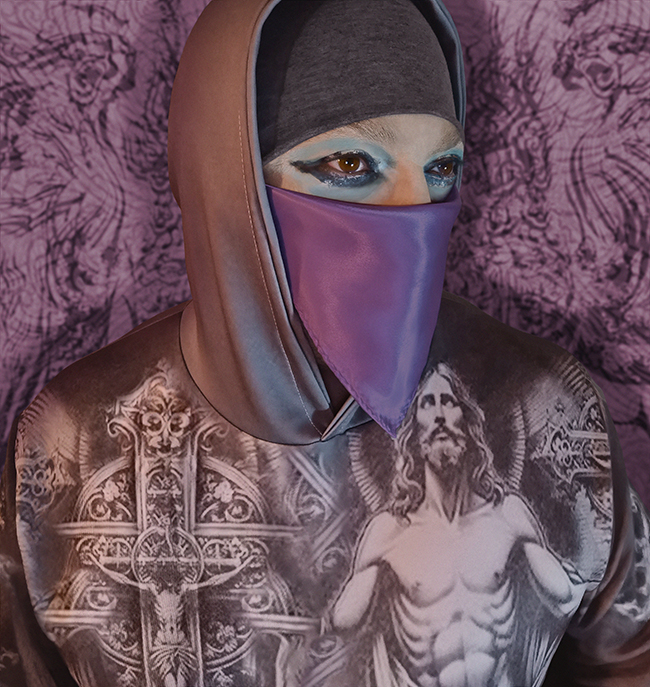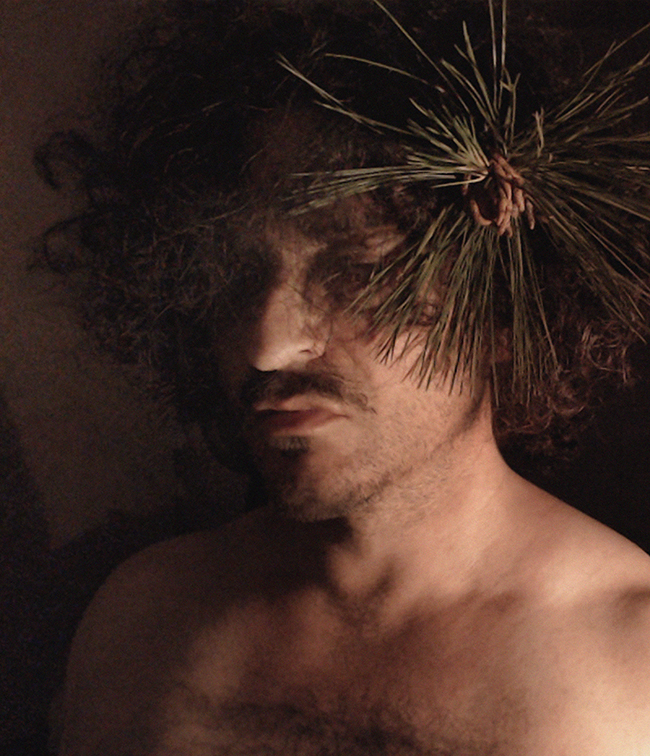Adamo Macri was born in Montreal in 1964 and studied a wide mix of disciplines at Dawson College—commercial art, photography, graphic design, art history, and fine arts. It shows. His work never sits comfortably in one category. Though he’s often grouped with sculptors, that only scratches the surface. He works in multiple mediums—photography, drawing, video, painting—and tends to blur the lines between them. His approach is idea-first. What holds it all together is his fixation on meaning: how a single word or image can carry history, slang, and myth, all at once.
Macri’s photographs are tightly composed, often with a central figure posed like a statue. But the titles unravel things. That’s where the trouble starts. A simple phrase will suddenly split open into double meanings and hidden references. Each piece is an image, yes—but also a puzzle, a trigger, or a quiet joke.

Male Head with Bugle (2024)
Photography, 84 x 89 cm
The image gives you what the title promises: a male figure, a bugle. But the surface is only a setup. “Bugle” isn’t just an instrument. It’s also slang—for a nose, for cocaine, for making noise. In military contexts, the bugle means commands and signals. On the street, it points to indulgence, maybe even chaos.
The photo itself doesn’t give away much. The man’s expression is neutral. Classical. Formal. But the title tilts the entire meaning. Is this a tribute to order or a nod to disorder? Is the figure blowing the horn or has something just blown through him? Macri turns a simple portrait into a collision of narratives—ceremony, slang, addiction, and authority. You feel the image settle into place while the title keeps slipping sideways. Kenneth Radu’s essay “Tricky Titles” calls attention to Macri’s way of dragging words into new contexts. That’s on full display here. The image stays still, but everything else moves.

Aerosol (2024)
Photography, 84 x 89 cm
Another portrait, but this one feels more diffuse—by design. “Aerosol” carries multiple associations. It’s a technical term for a substance released into the air. It’s cosmetic. It’s environmental. And in street culture, it means spray paint—graffiti. That tension between visibility and invisibility runs right through the piece.
The figure in the photo is posed, deliberate, like the others. But the title makes you think about dispersion, about what hangs in the air. Graffiti artists like Banksy made aerosol into something public, but also something fleeting. The piece plays with that balance: control vs. chaos, permanence vs. drift.
There’s no can in sight. No obvious message on a wall. But the idea is present. The photograph is crisp, clean, contained. Yet the word “aerosol” pulls you into something harder to contain—spray, rebellion, maybe even contamination. Again, Macri uses the title like a propellant. It sends your interpretation in new directions, fast.

Pinus Attis (2013)
Photography, 41 x 48 cm
This one dives straight into myth. Attis was a Phrygian god tied to the rhythms of nature. His story ends in self-castration and transformation into a pine tree—a symbol of rebirth. The title Pinus Attis fuses the Latin name for pine with the god’s own. That fusion sets the tone.
In the image, the subject is quiet. Nothing dramatic, no explicit narrative. But there’s weight in the stillness. If you know Attis’s story, you might sense that moment right before—or after—the cut. The pine tree becomes more than just a tree. It’s a container of pain, renewal, ritual. You begin to read the image as sacred, even though it never announces itself that way.
Macri doesn’t spell anything out. He lets the reference sit in the background, like a hum. But the myth still seeps through. The body in the frame is both person and symbol—tied to something older, seasonal, maybe even eternal.
In all three works, Macri keeps his grip on form. The compositions are spare, almost restrained. But the meanings churn underneath. His titles are doing heavy lifting, dragging the viewer into places they didn’t expect to go. These aren’t decorative portraits. They’re tools, traps, and provocations.
Macri seems less interested in telling a story than in bending one. He invites the viewer to stumble, rethink, get caught in a double meaning. Each image is a quiet surface layered over something louder—language, myth, slang, decay. That’s the tension he’s always working with. And that’s what makes the work keep echoing, long after you’ve looked away.

